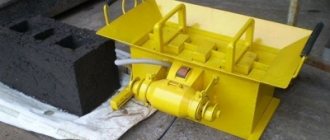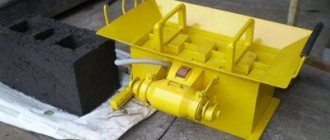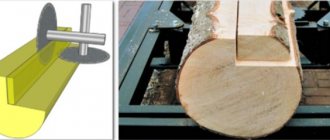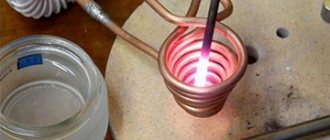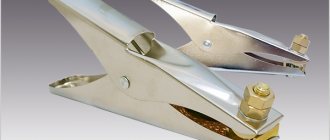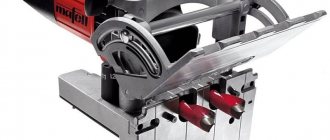Therefore, the elements can be manufactured in self-made devices. Let's figure out how to do this correctly so that neither the dimensions of the products nor their performance indicators are affected?
What are blanks?
Since cinder block material varies in size and appearance , there is no single template from which standard products can be produced. Therefore, in the production of slag concrete, special collapsible containers are used, consisting of 4 walls, a bottom (in some types of blanks a bottom is not provided) and matrices (one or several replaceable ones, depending on the size and size).
The number of matrices depends on the volume of products that need to be produced in 1 day. Matrices can be made of wood or metal.
Types of designs
Blanks for the production of cinder blocks are divided according to the material from which they are made and the number of voids in the future product. For the first category, you can write the following. They are:
- Plastic.
- Wooden.
- Metal.
Plastic
Plastic blanks for cinder block products on an industrial scale are not particularly popular. They will not be able to withstand constant pouring over a long period of time . This greatly limits their scope of application. Therefore, only a few manufacturers produce for sale plastic containers for pouring slag concrete.
The plastic structure comes in only one size – 390x190x188 mm.
But the advantage of such structures is that they are light in weight and easy to operate , because the walls of the workpiece do not need to be lubricated each time with used machine oil or a special self-destructive lubricant. In addition, their price is much cheaper than the same products made of metal or wood.
Wooden
Wooden structures are a rectangular box made of laminated plywood. They can be used both in production for the manufacture of large volumes of products, and for home production of cinder blocks.
To give the walls greater rigidity, clamps are used that tighten all 4 walls . And so that the cinder block solution does not destroy the structure from the inside, the bottom and walls are covered with polyethylene.
The advantages of containers made of wood are their average, affordable price (lower than those made of metal), light weight, making the workpieces easy to move around the site and lift, as well as the number of fills - on average 50 times.
But there is also a minus - the material is sensitive to moisture , so pouring the solution into wooden forms should only be done in the fresh air, in dry weather, and the filled forms should be stored in a well-ventilated, not damp area.
Metal
Metal forms come with or without a bottom. And the presence of a bottom divides metal products into solid and collapsible. If there is no bottom in the mold, then the walls of the product do not have sufficient rigidity, so in industrial production they mainly use blanks with a bottom 6 mm thick.
The bottom can be further strengthened with channels, and special metal inserts can also be used, which will allow the production of cinder blocks with a tongue-and-groove system (for partition slabs).
The most popular metal forms are made into 35, 63 or 70 blocks of standard sizes 390x190x188 mm .
How to make a mold for a cinder block with your own hands - setting up efficient home production
Such construction is classified as very economical, since even when purchasing building materials in a store, its cost is low. What can we say about the home production option - in this case, the costs of building a house will become completely ridiculous. Moreover, the process is not complicated. A do-it-yourself cinder block mold can be done even by a novice craftsman who has no experience in such work. And the procedure for manufacturing the elements is completely simple.
But first, let’s talk a little more about why cinder blocks are so popular, and whether it’s worth the bother of making them at home to build a future family nest.
Main characteristics
Building from such material is a pleasure. Light weight and large size simplify and speed up the laying process as much as possible. Even without hiring a specialized team, you can build a residential building in just a couple of days.
Like bricks, cinder blocks are made in two versions: solid and hollow. The first option is solid, there are few voids in its structure, due to which it is quite durable. The hollow version has three large holes in its structure, which play two roles at once.
Firstly, due to their presence, the weight of the block becomes extremely small. This significantly reduces the load on the foundation and makes the work of building walls even easier. Secondly, these holes can be filled with heat-insulating material, thus creating walls that perfectly retain heat.
However, everything is fine with the thermal conductivity of cinder blocks, as well as with the sound insulation characteristics. Heat is retained well, sound vibrations are well damped, so a house made from such material is very comfortable to live in.
Of course, all these qualities are possible only if the manufacturing technology of the building material has not been violated. Let's move on to the practical part to find out how the production process works and what is needed for it.
Material requirements
- coal slag (where the name of the material comes from), which can be replaced with zytoconcrete;
- expanded clay, pre-crushed;
- gravel;
- cement;
- water.
Ingredients should be chosen carefully, because the quality of the final product depends on it. Cement, for example, must have a strength grade of at least M400. Gravel should be taken with fractions from 5 to 10 millimeters.
I’ll say something about water. For some reason, many people believe that the production of building materials is rough work, and therefore you can splash liquid from the nearest swamp into the composition, cement will tolerate everything. In fact, this can ruin any endeavor.
Water taken from a river or other nearby body of water is not clean. This will directly affect the characteristics of the finished product, reducing performance. For example, such water contains various organic impurities. During the production process, they will begin to rot, releasing air. And excess air in the structure of the material automatically means a loss of strength characteristics.
In general, it’s not worth saving money and effort on such a seemingly simple thing as water. You need to take one that you personally can drink without boiling. Only then can the manufactured material boast high quality.
We recommend reading:
To do this, scoop up a handful of the mixture, squeeze it to form a lump, and drop it on the floor. Two points are important: initially the lump should stick together well, and when it hits the floor surface it should crumble. This means that all proportions are correct.
Manufacturing process
Wood forms
This is the simplest option. The wooden form is a banal box. You can make separate ones for each element, but the optimal solution is to create one large form, divided into cells using inserts.
Drawings for such a product are not mandatory; there is nothing complicated there. The most important thing is to maintain the correct dimensions. When making a large frame, keep in mind that some of the internal volume will be taken up by the thickness of the partitions, so calculate the dimensions in accordance with this factor.
- there is no need to do the bottom. The form is placed on some flat surface - table, floor, etc. - covered with polyethylene, and after that the mixture is poured into it;
- The partitions inside the frame should be made removable, fastening them together using specially made cuts. An external frame will support this entire structure along the perimeter. This approach will make removing finished blocks simple and convenient;
- The wooden parts of the structure should be coated with oil paint, this will prevent the mixture from sticking to the walls. Naturally, the coating must be completely dry before use;
- hollow blocks are made using exactly the same mold, but in the cells already filled with solution, glass bottles should be placed upside down, three for each block. The excess mixture that rises must be removed. The bottles are removed five to six hours after the drying process begins, and then the blocks are left for another 24 hours before they can be removed from the cells.
Machine
The solution for such production is made thicker than for pouring into a wooden mold. This allows for less shrinkage when the blocks dry.
The machine is assembled according to the following drawings:
Is it possible to make it yourself?
For a large volume of cinder block production, you need not to have homemade equipment and blank molds, but high-quality devices that would create the ideal geometry of the products.
But in order to make blocks only for private, small-scale construction, it is not necessary to buy expensive tools and equipment . You can make molds for cinder concrete with your own hands, simply using available materials.
Even if you don’t have the material at home from which you can make molds, you can ask your neighbors, family and friends. Surely, in the bins of their garage, shed or attic there are several pieces of sheets of steel, metal, iron, wood, and boards. A little active search and perseverance - and materials for blanks will be found.
To build your own molds you will need:
- material for the walls of the mold (metal, iron, wood, plastic);
- self-tapping screws, bolts, nuts - for twisting elements together;
- grinder, metal scissors, hacksaw - for cutting the material into the required pieces according to size (depending on what material will be chosen);
- vices and clamps - for connecting the sides of the form and giving them rigidity;
- welding machine;
- a sheet of metal or steel to create the bottom (approximately 3-6 mm thick);
- a pipe with a diameter of about 9 cm or wine or champagne bottles - to create voids in the future block;
- fittings with a diameter of 12 mm.
Homemade machines with a vibrating device
Homemade machine diagram
Vibrating machines for making cinder blocks are more advanced equipment. Making blocks using them is faster and more convenient, since you don’t have to wait for the solution to set. In this case, the concrete solution is prepared more rigid and thick, it should have a slight shrinkage.
Technically, this is implemented in two ways:
using a vibrating table;
Vibrating table
equipping the mold itself with a motor, on the shaft of which an eccentric with a displaced center of gravity is installed.
A machine with an eccentric is more convenient for producing large quantities of material, since it allows you to obtain a finished block in one go without turning over.
Homemade machine according to the “laying hen” scheme
Machine – “laying hen”
The given drawing of a machine for making cinder blocks is one of the simplest.
Its design includes the following basic elements:
- molding box - matrix (it has no bottom);
- vibrator on the side wall;
- drawer handles designed for easy removal without damaging the impression shape;
- replaceable sets of pressure plates;
- void formers for various void shapes.
The current standard provides for the established dimensions of one such block - 39 x 19 x 18.8 cm. In this case, the voidness should not exceed 30%.
Matrix manufacturing
- Sheet metal is taken (from 3 mm);
- A shape is cut out of the sheet to the size of one block (5 cm is added to the indicated dimensions for compaction);
- A through box is formed (no bottom);
- Special strips welded at the ends give the box greater stability. For this purpose, profile pipes with a small cross-section are used;
- The base of the matrix is upholstered with sheet rubber, which will serve to protect the lower edges of the matrix from deformation;
- An apron is formed for the edging, which will prevent the solution from spilling when filling the mold;
- Handles are attached.
Instructions for creating homemade containers
Containers for homemade molds can be of different sizes, both standard and non-standard. It all depends on the wishes of the owner and his preferences.
Please note : the larger the blocks, the less mortar will be needed to lay them and the fewer cold bridges there will be through the seams between the products.
Large blocks in size are convenient and practical, but it is better not to make forms over 2 m in length or width , because such formwork will be bulky and difficult to transport and lift. It is better to make several formworks, but smaller ones.
To make your own mold, you need to:
- First, decide on the dimensions of the future workpiece, and then cut out the building material according to these dimensions (4 walls, bottom and, if necessary, partitions).
- Set the height of the elements and cut the walls to this height.
- The walls of the formwork must be mounted in such a way that the transverse parts are inserted into the longitudinal ones and thereby form cells of the same size.
- Form the bottom from building material or line it with cellophane instead of the bottom.
- If you need to make hollow cinder blocks, then you will also need void formers for these purposes. They can be wine or champagne bottles filled with water. Bottles can replace pipes with a diameter of about 6 cm or rectangular wooden blocks.
- Insert void formers into the container and secure them. The number of voids in the finished product should not exceed 40% of the total mass of the block.
- Pour the solution and wait a day so that the material can be removed from the mold and transferred to the place for subsequent drying.
What is needed to produce blocks, making molds
In order to make a cinder block with your own hands, you need to purchase in large quantities all the components of the mixture, which necessarily includes cement and fillers, as well as various additives that improve the quality of the building material.
For production you will need a concrete mixer, a vibrating sieve and a vibrating machine. Particular attention should be paid to the molds for making blocks.
You will need as many forms as you plan to make blocks per day. Molds can be made from wood or metal. For void formers, pipes of the required diameter are taken. You can also make rectangular void formers, but you need to take into account that the voidness of the block should not exceed 40%.
Drawing of a mold for making cinder block
You can also make machines for producing cinder blocks with your own hands. Detailed drawings will help with this.
If you have a lot of time, you can make blocks without using a machine, just using molds. To do this, you need to pour the solution into it by a third, then tap its walls with a hammer along the entire perimeter so that the mixture settles. Then you need to pour the mixture again and repeat the action. Plastic bottles filled with water can be used as void formers. They need to be inserted at the same distance from each other. In this case, it will take 2-4 days to dry, after which the block can be removed and a new one prepared.
When using high-quality cement and strictly following production technology, blocks made by yourself are no less quality than those produced at the enterprise.
Difficulties and errors during work
If a person does not have the ability to work with his own hands, then it is better not to undertake making cinder blocks on his own. Despite the fact that cinder blocks may not be a certified product, they must be manufactured using technology. Therefore, it is necessary to carefully calculate the dimensions of the walls and bottom of the formwork so that the finished blocks are of the correct shape and dimensions.
For better production of cinder blocks, you need to use additional equipment, such as a vibrating machine. This will allow you to compact the product and give it the desired shrinkage. But you will either have to buy such equipment or make it yourself.
If you do not lubricate the mold walls with machine oil, oil paint or special lubricant before pouring the solution, then it will be very difficult to remove the products from the workpiece. The elements should be removed from the mold the next day , but so that they do not crumble in your hands when removing them.
To avoid difficulties and not make mistakes when making cinder blocks at home, it would be useful to watch a video on this topic:
Proportions of solution for making cinder blocks
There is a specific recipe for the production of cinder blocks:
- The main filler is 7 parts. Slag filling is usually used, but it can be replaced with crushed ceramic bricks, gypsum, sawdust, gravel and other similar components.
- Cement - 1.5 parts. You should take cement of a grade no lower than M400.
- Sifted sand - 2 parts.
- Water until thick. To determine the optimal thickness of the solution, you need to squeeze the solution in your hand and then throw a handful on the ground. At normal density, the solution will disintegrate, and when compressed again, a single mass will form again.
The cinder block production technology provides for the additional introduction of a plasticizer intended for concrete into the solution. It helps to increase product strength, water resistance and frost resistance. The plasticizer is taken in the amount of 5 g per 1 block.
Cinder concrete blocks - characteristics and purpose of the material
One of the reasons for the increased popularity of slag-filled concrete blocks is the low cost of the material. It is associated with the use of waste from metallurgical enterprises - slag - in the production process.
Along with traditional components, Portland cement and river sand, various aggregates are used:
- brick break;
- crushed stone screening;
- granite chips;
- various slags and ash;
- expanded clay particles.
The use of cinder blocks in construction allows you to reduce the cost of constructing walls several times.
The manufacturing process is carried out in various ways:
- industrial method at specialized enterprises with processing of products in drying chambers;
- at home from available raw materials, using a self-assembled machine for making blocks.
Using homemade equipment you can produce various types of slag concrete products:
- full-bodied, with an increased margin of safety. They are used quite rarely, as they retain heat less well;
- hollow, characterized by high thermal insulation properties. To ensure strength, the volume of cavities should not exceed 1/3 of the total volume of the product.
The dimensions of the products are determined by the dimensions of the mold. When making products yourself, the size of the molding box can be any. However, many people prefer the standard dimensions of 19x18.8x39 cm.
The increased volume of the slag concrete block can significantly reduce the duration of various types of construction work:
- construction of capital walls;
- construction of internal partitions.
It is perfect for the construction of utility buildings, sheds, and storage buildings.
If you need to make a cinder block yourself, the machine allows you to quickly solve the problem. The resulting material has many advantages:
- high thermal insulation characteristics. Due to reduced thermal conductivity, the material prevents heat loss;
- increased dimensions and low weight. This makes it easy to transport products and quickly build walls from them;
- resistance to the development of microorganisms. This is achieved due to the properties of the slag included in the structure of the block;
- low price. A cinder block machine with your own hands allows you to make products that are cheaper than purchased blocks.
The advantages also include the fact that slag-filled blocks are easy to machine, effectively absorb various noises, and are not afraid of elevated temperatures.
The material also has weaknesses:
- low durability. The period of operation of buildings made of slag concrete is up to three decades;
- reduced safety margin. The characteristics of the material allow the construction of buildings no more than two floors high;
- the appearance of cracks under the influence of shear forces. During shrinkage, cracking occurs along the cinder block mass.
Read also: Do-it-yourself drill for a walk-behind tractor
To ensure an attractive appearance of buildings, the cinder block surface needs external cladding. These disadvantages do not stop developers who want to build a utility building or a small building in a limited time at low costs.
You can use homemade cinder blocks a month after they are made.
Features of homemade machines
Types of equipment for the production of expanded clay concrete blocks:
- Manual vibration machines.
- Mobile mechanized machines.
- Vibrating tables.
- Vibrating presses.
Manual vibrating machines
Consist of an electric motor and a vibration stand. The mixture is placed into molds. The equipment allows you to produce solid or hollow blocks. Technical equipment has stationary or removable void formers.
The disadvantage is low power and low productivity. All processes take place with the direct participation of humans. The equipment power does not exceed 2.0 kW.
Mobile mechanized machines
Equipped with vibration equipment for expanded clay concrete blocks with a power of 2 to 10 kW. Trailed or removable casters are used for movement. To perform additional functions they are equipped with modular systems.
The advantage is the ability to move freely, small dimensions, low cost.
The disadvantage is the low productivity and energy consumption of the equipment.
Vibrating tables
They are a spatial structure with an electric motor and a vibration device. The table surface consists of a steel tray. For its manufacture, galvanized steel sheet with a thickness of 3 mm with sides is used.
The molds filled with the mixture are placed on a pallet. Under the influence of vibration, the solution is compacted and takes the required shape. After this, the products are sent for drying.
The advantage of vibrating tables is their simplicity of design, maintenance, and minimal equipment cost.
The disadvantage is low productivity and a large proportion of manual labor.
Vibrating presses
Used in industrial enterprises. They have a power of up to 500 kW. Equipped with automation and non-destructive testing devices for finished products.
The equipment operates in automatic and semi-automatic mode at all stages of production. Productivity reaches 150 or more cubic meters of products per shift.
Making cinder blocks on a machine
Photo of the structure from different angles
The machine can significantly increase work productivity. The equipment has a fairly simple design.
Vibrating machine
Assembling the machine
The main element of a homemade vibratory compacting machine is a mold (matrix) for slag concrete mortar. By its design, this form is a metal box with internal elements in the form of voids. The void stoppers can also be removable.
Compact cinder block machine
The work kit includes the following materials and tools:
- welding machine;
- standard set of locksmith tools;
- grinder;
- vice;
- sheet steel 3mm thick. It will take about 1 m2;
- a pipe with a diameter of 7.5-9 cm. Approximately 1 m of pipe is needed;
- metal strip 3 mm thick. You will need about 30 cm of material;
- electric motor with a power of 0.5-0.75 kW;
- nuts;
- bolts.
Compact cinder block machine
Side view
Front view
Front view
First step. We make a mold according to the size of the future blocks. We cut out the side faces of the matrix from sheet steel. We will make a form for 2 blocks at once. To do this, we cut out the inner central partition from steel and fix it in the box.
Second step. We determine the height of the elements to decorate the voids.
Important! In accordance with the technology, the height of the voids should be such that the bottom wall has a thickness of 3 cm.
Third step. We cut 6 pieces of pipe along the length of the limiting cylinders to form voids.
Fourth step. We give the pipes a conical shape. To do this, we cut each piece of pipe longitudinally to the middle, compress it with a vice and connect it using a welding machine. We brew each cone on both edges.
Fifth step. We connect the stops in a row along the long edge of the cinder block. Along the edges of the row we add a 3-centimeter thick plate with holes for fastening with eyes.
Sixth step. We make a cut in the middle of each such compartment. We weld lugs on the back side of the form. They will allow temporary fastening of elements to create voids. A very convenient solution - it will be possible to remove the cylinders and make monolithic blocks.
Compact cinder block machine (press on top)
Press machine
Press machine
Seventh step. On the outside of one of the transverse walls we weld 4 bolts for the mounting holes of the vibration motor.
Eighth step. Using welding, we attach an apron on the loading side and blades along the edges.
Ninth step. We prepare all structural elements for painting - we clean them and thoroughly polish them.
Tenth step. We do the press. It will look like a plate with holes repeating the location of the holes in the block.
Important! The diameter of the holes on the plate should exceed the same parameter for the recesses in the block by approximately 0.5 cm.
We make the plate of this size and fix it in such a way that it can go deep into the box at the place where the limiters are installed by 5-7 cm.
Finally, all that remains is to weld the handles to the press, coat the structure with a primer mixture and mount the vibration motor.
An ordinary electric motor can be converted into a suitable vibration motor. To do this, it is necessary to weld eccentrics onto the engine shafts. We won’t bother too much - we’ll just weld the bolts so that their axes coincide. To regulate the frequency and strength of vibration, screw nuts onto the welded bolts.
Compact cinder block machine
Motor
Motor
Vibration device
Prices for machines for cinder blocks
Cinder block machine
Making blocks
Recommendations for preparing the solution are given above. You can use the standard recipe or modify it at your discretion. The main thing is to obtain optimal viscosity. It can be determined “by eye” - the lump of mixture should hold its shape steadily.
Before loading the mixture, lubricate the contact metal surfaces with oil. Thanks to this, the solution will not stick to the iron.
We place the finished mixture into the matrix and begin pressing.
Place the filled forms on a vibrating plate and let it compact the solution for 5-15 seconds. After the specified time, add more solution to the mold, because previously loaded will inevitably settle.
We repeat the process, only this time we do not turn off the vibrating plate until the clamp reaches the limiters. We remove the mold until the machine stops.
Ready cinder block
We give the blocks 1-3 days for initial drying, carefully remove them from the blocks, lay them out on a flat horizontal surface and cover them with plastic wrap. The material can be used for its intended purpose no earlier than after a month.
Comparison of characteristics of cinder blocks and foam blocks
Find out how to make wood concrete blocks with your own hands from our new article.
Good luck!
